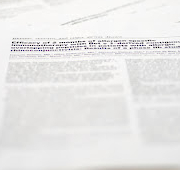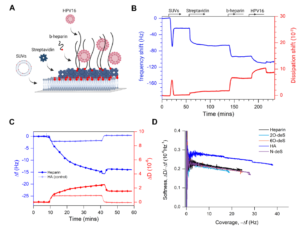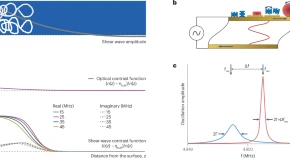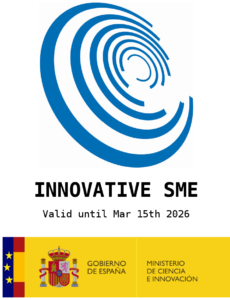Exploiting the high affinity between cellulose nanofibrils and Aloe vera acemannan to develop elastic, crosslinker-free, all-polysaccharide hydrogels
Authors: Ngoc Huynh, Lukas Fliri, Juan José Valle-Delgado, Monika Österberg
Journal: International Journal of Biological Macromolecules
Abstract: Plant-based polymers hold promising prospects thanks to their bioactivity, diversity and versatility but they are currently overshadowed by synthetic and animal-derived materials, especially in biomedical applications. In this study, we developed an entirely plant-based hydrogel with improved mechanical performance based on TEMPO-oxidized cellulose nanofibrils (TCNFs) and the polysaccharide fraction (AVPF) extracted from Aloe vera L. (Aloe barbadensis Miller). The hydrogel blends exhibited excellent viscoelastic properties, minimal shrinkage and a significant increase in compressive modulus (ranging from 2.7 to 13.2 kPa versus 0.8 kPa in single component hydrogels), suggesting a synergistic effect. In-depth analysis of interaction and morphology of the hydrogels by QCM-D, AFM and SEM imaging showed that the observed synergy was the result of the complementary action between the two components and a uniform spatial distribution of the two networks. TCNFs built the rigid skeleton for the hydrogels, while AVPF physically adsorbed on TCNFs, forming a flexible matrix, allowing for better load transfer and dissipation in both static and dynamic loading, leading to a remarkable increase in moduli that surpassed the mere sum of the two individual components. In addition, the obtained hydrogels also showed little to no perceptible shrinkage after drying, unlike the single-component hydrogels made from the initial materials. These hydrogels offer a sustainable and ethical alternative to animal-derived materials, with great potential in biomedical fields.


 Abstract:
Abstract:  Abstract:
Abstract: 
 Abstract:
Abstract:  Abstract:
Abstract:  Abstract:
Abstract:  This paper reports the real time monitoring of siderite deposition, on both Au- and Fe-coated surfaces, using the changes in frequency and dissipation of quartz crystal microbalance with dissipation (QCMD). In an iron chloride solution saturated with carbon dioxide, buffered with sodium bicarbonate to pH 6.8, roughly spherical particles of siderite formed within 15 min, which subsequently deposited on the QCMD crystal surface. Imaging of the surface showed a layer formed from particles ca. < 0.5 μm in diameter. Larger particles are clearly deposited on top of the lower layer; these larger particles are >1 μm in diameter. Monitoring of the frequency clearly differentiates the formation of the lower layer from the larger crystals deposited on top at later times. The elastic moduli calculated from QCMD data showed a progressive dissipation increase; the modeling of the solid–liquid interface using a flat approximation resulted in a poor estimation of elastic and storage moduli. Rather, the impedance modeled as a viscoelastic layer in contact with a semi-infinite liquid, where a random bumpy surface with a Gaussian correlator is used, is much more accurate in determining the elastic and storage moduli as losses from the uneven interface are considered. A further step considers that the film is in fact a composite consisting of hard spherical particles of siderite with water in the vacant spaces. This is treated by considering the individual contributions of the phases to the losses measured, thereby further improving the accuracy of the description of the film and the QCMD data. Collectively, this work presents a new framework for the use of QCMD, paired with traditional approaches, to enhance the understanding of crystal deposition and film formation as well as quantify the often evolving mechanical properties.
This paper reports the real time monitoring of siderite deposition, on both Au- and Fe-coated surfaces, using the changes in frequency and dissipation of quartz crystal microbalance with dissipation (QCMD). In an iron chloride solution saturated with carbon dioxide, buffered with sodium bicarbonate to pH 6.8, roughly spherical particles of siderite formed within 15 min, which subsequently deposited on the QCMD crystal surface. Imaging of the surface showed a layer formed from particles ca. < 0.5 μm in diameter. Larger particles are clearly deposited on top of the lower layer; these larger particles are >1 μm in diameter. Monitoring of the frequency clearly differentiates the formation of the lower layer from the larger crystals deposited on top at later times. The elastic moduli calculated from QCMD data showed a progressive dissipation increase; the modeling of the solid–liquid interface using a flat approximation resulted in a poor estimation of elastic and storage moduli. Rather, the impedance modeled as a viscoelastic layer in contact with a semi-infinite liquid, where a random bumpy surface with a Gaussian correlator is used, is much more accurate in determining the elastic and storage moduli as losses from the uneven interface are considered. A further step considers that the film is in fact a composite consisting of hard spherical particles of siderite with water in the vacant spaces. This is treated by considering the individual contributions of the phases to the losses measured, thereby further improving the accuracy of the description of the film and the QCMD data. Collectively, this work presents a new framework for the use of QCMD, paired with traditional approaches, to enhance the understanding of crystal deposition and film formation as well as quantify the often evolving mechanical properties. The misregulation of protein phosphatases is a key factor in the development of many human diseases, notably cancers. Here, based on a 100 MHz quartz crystal microbalance (QCM) biosensing platform, the dephosphorylation process of phosphopeptide (P-peptide) caused by protein tyrosine phosphatase 1B (PTP1B) was monitored in real time for the first time and PTP1B activity was assayed rapidly and sensitively. The QCM chip, coated with a gold (Au) film, was used to immobilized thiol-labeled single-stranded 5′-phosphate-DNAs (P-DNA) through Au–S bond. The P-peptide, specific to PTP1B, was then connected to the P-DNA via chelation between Zr4+ and phosphate groups. When PTP1B was injected into the QCM flow cell where the P-peptide/Zr4+/MCH/P-DNA/Au chip was placed, the P-peptide was dephosphorylated and released from the Au chip surface, resulting in an increase in the frequency of the QCM Au chip. This allowed the real-time monitoring of the P-peptide dephosphorylation process and sensitive detection of PTP1B activity within 6 min with a linear detection range of 0.01–100 pM and a detection limit of 0.008 pM. In addition, the maximum inhibitory ratios of inhibitors were evaluated using this proposed 100 MHz QCM biosensor. The developed 100 MHz QCM biosensing platform shows immense potential for early diagnosis of diseases related to protein phosphatases and the development of drugs targeting protein phosphatases.
The misregulation of protein phosphatases is a key factor in the development of many human diseases, notably cancers. Here, based on a 100 MHz quartz crystal microbalance (QCM) biosensing platform, the dephosphorylation process of phosphopeptide (P-peptide) caused by protein tyrosine phosphatase 1B (PTP1B) was monitored in real time for the first time and PTP1B activity was assayed rapidly and sensitively. The QCM chip, coated with a gold (Au) film, was used to immobilized thiol-labeled single-stranded 5′-phosphate-DNAs (P-DNA) through Au–S bond. The P-peptide, specific to PTP1B, was then connected to the P-DNA via chelation between Zr4+ and phosphate groups. When PTP1B was injected into the QCM flow cell where the P-peptide/Zr4+/MCH/P-DNA/Au chip was placed, the P-peptide was dephosphorylated and released from the Au chip surface, resulting in an increase in the frequency of the QCM Au chip. This allowed the real-time monitoring of the P-peptide dephosphorylation process and sensitive detection of PTP1B activity within 6 min with a linear detection range of 0.01–100 pM and a detection limit of 0.008 pM. In addition, the maximum inhibitory ratios of inhibitors were evaluated using this proposed 100 MHz QCM biosensor. The developed 100 MHz QCM biosensing platform shows immense potential for early diagnosis of diseases related to protein phosphatases and the development of drugs targeting protein phosphatases.
